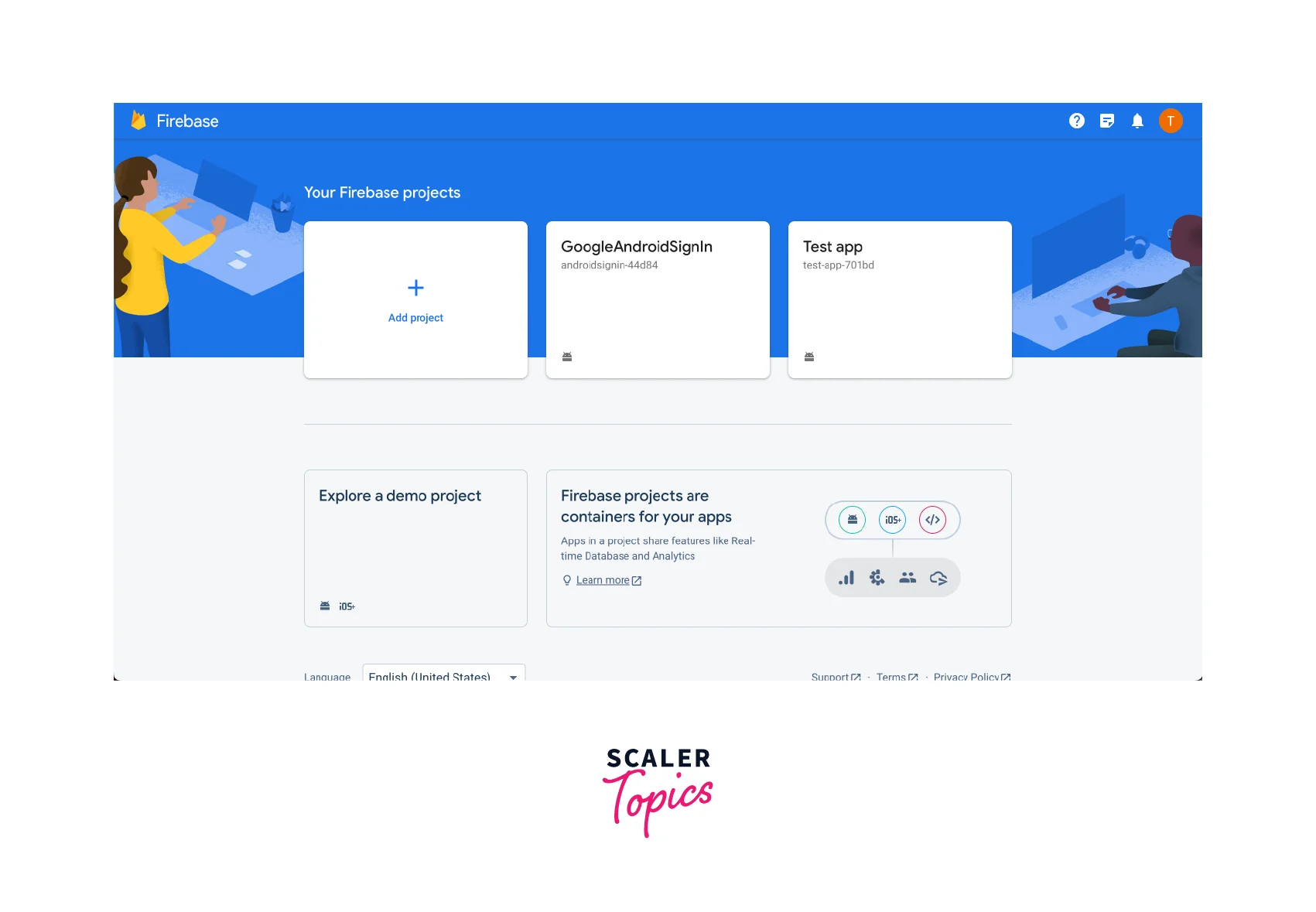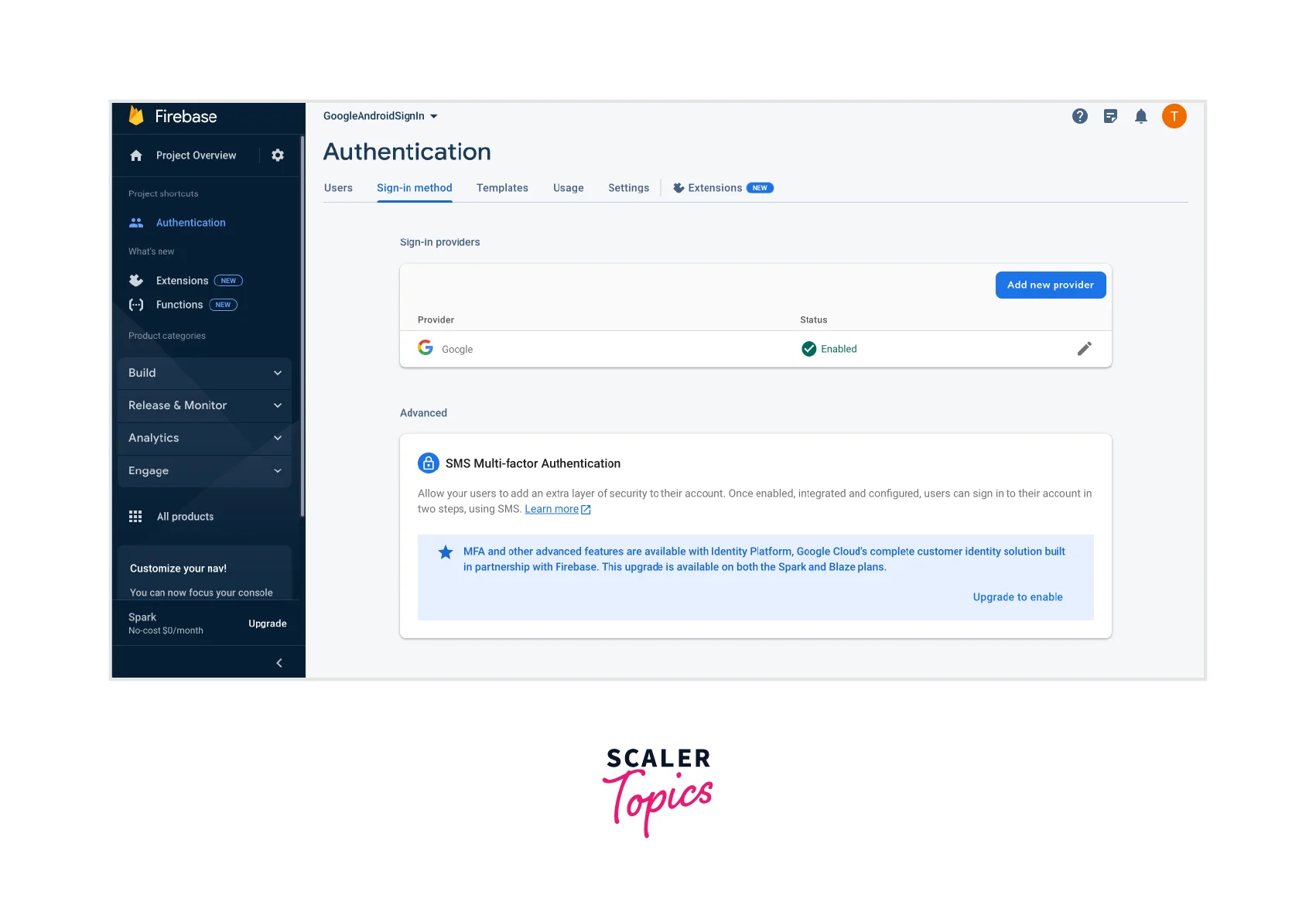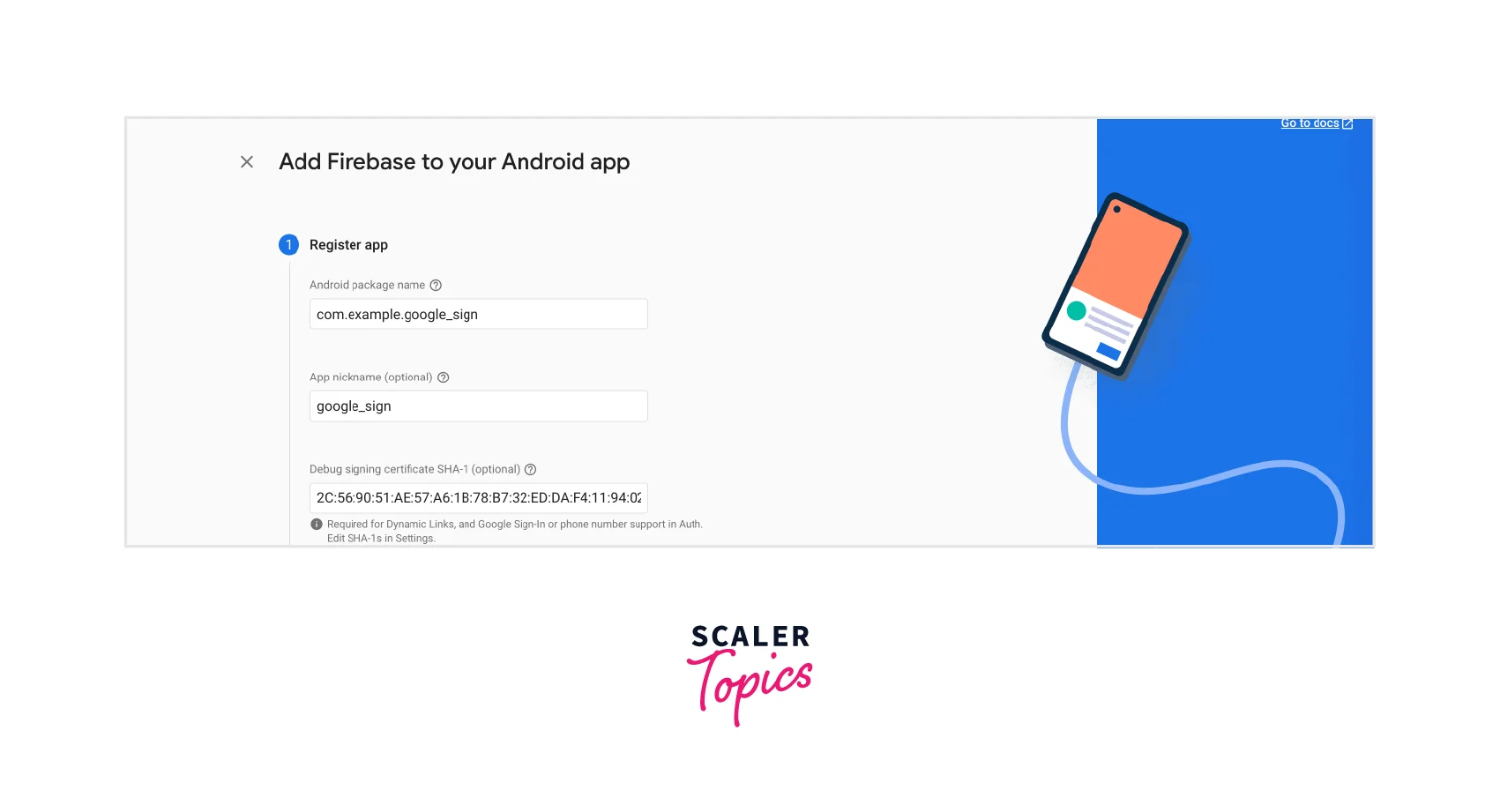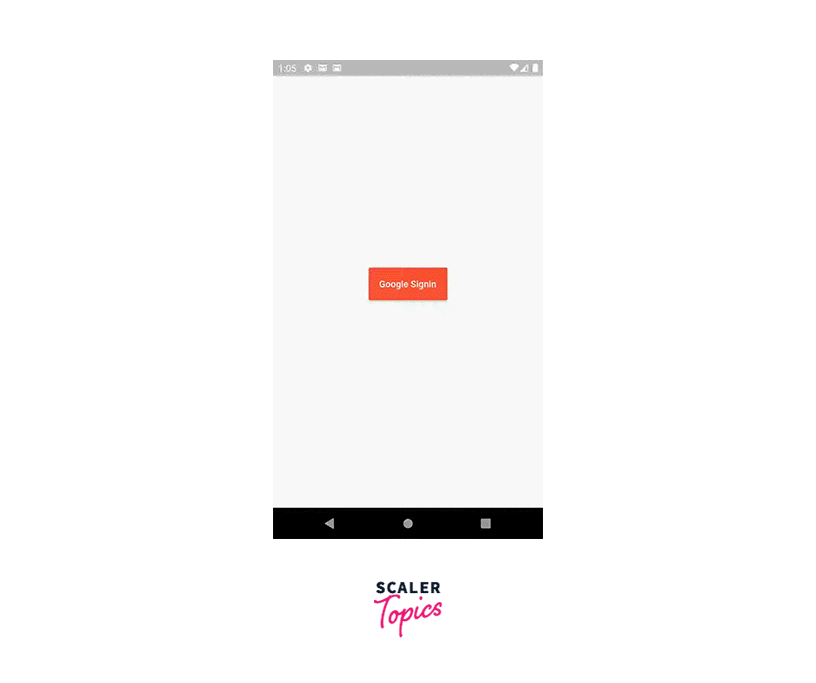How to Implement Google Sign in With Flutter?
Google Sign-In in Flutter provides a smooth and secure method for users to log in using their Google accounts, making authentication simpler. Now, let's discuss how to set up Google Sign-In in Flutter.
Setting up Google Sign-In in Flutter
As we have now understood the various advantages offered to us by the Google sign in flutter we need to understand how to set it up in our flutter application. This is the most basic starting step in the entire process of using google sign in flutter to allow a secure login option. In this section, we shall learn the
To set up Google Sign-In in a Flutter application, you need to follow these steps:
Step 1: Configure Firebase Project
Create a new Firebase project or use an existing one at the Firebase console. Enable Google Sign-In in the Firebase Authentication section. Add your Android and iOS app to the Firebase project by following the provided instructions for each platform. Make sure to provide the correct package name (Android) and bundle identifier (iOS).
Step 2: Add Dependencies Open your Flutter project in your preferred code editor. Open the pubspec.yaml file and add the following dependencies:
Save the file, and run flutter pub get in the terminal to download the new dependencies.
Step 3: Configure Android App
For Android, open the android/app/build.gradle file and add the following line inside the dependencies section: implementation 'com.google.firebase:firebase-auth:21.0.1'
Save the file.
Step 4: Configure iOS App
For iOS, open the ios/Podfile and add the following line inside the target section:
Save the file, and run pod install in the ios folder using the terminal.
Step 5: Implement Google Sign-In in Flutter
- In your Flutter code, import the necessary packages:
- Initialize Firebase in your main function:
- Create a GoogleSignIn instance:
- Implement the Google Sign-In flow. Here's an example for signing in:
- Call the signInWithGoogle() function when the user triggers the sign-in action.
These steps should help you set up Google Sign-In in your Flutter application. Remember to handle error cases and customize the user experience as per your app's requirements.
Implementing Google Sign In in Flutter
After you have set up google sign-in in flutter, here is the approach to implement it in your project.
- Set up a new Flutter project:
Start by creating a new Flutter project using the Flutter SDK and your preferred IDE. - Add necessary dependencies:
Open your project's pubspec.yaml file and add the required dependencies for Google Sign In. You can use the google_sign_in package, which is an official Flutter package provided by Google. Make sure to run flutter pub get to fetch the dependencies. - Obtain API credentials:
Go to the Google Developers Console and create a new project. Enable the Google Sign-In API and generate the necessary credentials (client ID and secret). Make sure to configure the authorized redirect URI for your Flutter app. - Configure Android and iOS platforms:
Follow the instructions provided by the google_sign_in package to configure the required settings in your Android and iOS projects. This typically involves adding the credentials and making changes to the Android Manifest and Info.plist files. - Implement Google Sign In in your Flutter app:
In your Flutter project, create a new Dart file or modify an existing one to handle the Google Sign In functionality. Import the necessary packages, initialize the GoogleSignIn object, and implement the authentication flow using the provided methods (signIn, signOut, etc.). You can refer to the package documentation for more details on the available methods and options. - Design your application:
Create the user interface for your application using Flutter's widgets. Design the login screen with a Google Sign In button to initiate the authentication process. You can use Flutter's MaterialButton or customize it with Flutter's InkWell and GestureDetector widgets. - Test and debug:
Run your Flutter app on different devices and test the Google Sign In functionality. Verify that the authentication flow works as expected and that the user's Google credentials are successfully obtained.
Remember to handle errors and edge cases during the authentication process, such as network connectivity issues, user cancellation, and token expiration.
Please note that the implementation details may vary depending on the specific Flutter version and the packages you choose to use. It's recommended to consult the official documentation and package references for the most up-to-date instructions and guidelines.
Using Google Sign In with Firebase
Using Google Sign-In with Firebase in a Flutter application allows users to sign in using their Google credentials and utilize Firebase's authentication and other services. Here's a step-by-step guide to implementing Google Sign-In with Firebase in your Flutter app.
To implement Google Sign In with Firebase in your Flutter application, follow these steps:
- Set up a new Flutter project:
Create a new Flutter project using the Flutter SDK and your preferred IDE. - Set up Firebase project:
Go to the Firebase Console and create a new project. Follow the instructions to set up Firebase for your Flutter application. Download the google-services.json file for Android or the GoogleService-Info.plist file for iOS, and place them in the respective project folders (android/app for Android and ios/Runner for iOS). - Add necessary dependencies:
Open your project's pubspec.yaml file and add the required dependencies for Firebase and Google Sign-In. Include firebase_core, firebase_auth, and google_sign_in packages. Run flutter pub get to fetch the dependencies. - Configure Android and iOS platforms:
For Android, make sure you have updated the build.gradle file in your android/app folder with the Firebase configuration. For iOS, update the AppDelegate.swift file in the ios/Runner folder with the Firebase configuration. - Enable Google Sign In in Firebase Console:
In the Firebase Console, go to your project's Authentication section and enable Google as a sign-in provider. Provide the necessary information, such as the Android package name and SHA-1 fingerprint for Android, and the iOS bundle identifier for iOS. - Implement Google Sign In in your Flutter app:
In your Flutter project, create a new Dart file or modify an existing one to handle the Google Sign In functionality. Import the necessary packages (firebase_core, firebase_auth, and google_sign_in), initialize Firebase using Firebase.initializeApp(), and set up the Google Sign In object using GoogleSignIn(). - Implement the authentication flow:
Use the GoogleSignIn object to handle the authentication flow. When the user taps the Google Sign In button, call signIn() to initiate the sign-in process. Once the user is signed in, you can obtain the user's credentials, such as the access token and user ID, to perform further operations. Use the FirebaseAuth package to create or sign in with a Firebase user using the obtained Google credentials. - Design your application:
Create the user interface for your application using Flutter's widgets. Design the login screen with a Google Sign In button to initiate the authentication process. You can use Flutter's MaterialButton or customize it with Flutter's InkWell and GestureDetector widgets. - Test and debug:
Run your Flutter app on different devices and test the Google Sign-In functionality with Firebase integration. Verify that the authentication flow works as expected and that the user's Google credentials are successfully obtained and used for Firebase authentication.
Remember to handle errors and edge cases during the authentication process, such as network connectivity issues, user cancellation, and token expiration. Refer to the Firebase and Google Sign-In documentation for more details on handling different scenarios.
Once you have implemented Google Sign In with Firebase in your Flutter app, you can take screenshots of your application to share or showcase its functionality.
Best Practices for Google Sign In in Flutter
When implementing Google Sign-In in Flutter, it's important to follow best practices to ensure a secure and smooth user experience. Using best practices for Google Sign In is crucial for several reasons:
- Security:
Implementing Google Sign In correctly ensures a secure authentication process. Following best practices helps protect user data and prevents unauthorized access. It helps you implement strong security measures, such as token validation and secure transmission of data, to safeguard user accounts. - User Experience:
Best practices help provide a seamless and intuitive user experience. By following recommended guidelines, you can create a smooth sign-in process, reducing friction for users and increasing the chances of successful sign-ins. This includes utilizing clear error messages, handling edge cases, and providing appropriate feedback to users. - Compatibility:
Following best practices ensures compatibility across different platforms and devices. Google Sign In has specific guidelines and requirements for both Android and iOS, and adhering to them ensures that your implementation works consistently across various operating systems and versions. - Future-proofing:
Google Sign In is an evolving technology, and best practices help future-proof your application. By staying up-to-date with the latest recommendations and updates from Google, you can ensure that your implementation remains compatible and secure as new features and improvements are introduced. - Community Support:
Adhering to best practices makes it easier to seek help and support from the developer community. By following established conventions, you can benefit from the expertise of others and find resources, tutorials, and code examples that align with best practices. - Maintainability and Scalability:
Implementing Google Sign-In using best practices promotes code maintainability and scalability. Following structured and organized coding patterns allows for easier troubleshooting, debugging, and code maintenance. It also enables you to scale your application efficiently and add new features or integrations in the future.
Here are some best practices for Google Sign-In in Flutter:
- Implement Error Handling:
Handle error scenarios properly by providing meaningful error messages and appropriate feedback to the user. Catch and handle exceptions during the sign-in process to provide a smooth and error-free experience. - Secure API Keys:
Store your API keys securely. Avoid hardcoding them directly in your code. Instead, consider using environment variables or secure storage solutions like Flutter Secure Storage or Keychain (iOS) and SharedPreferences (Android). - Use Firebase Authentication:
Integrate Google Sign-In with Firebase Authentication. Firebase provides robust authentication features, user management, and additional security measures to protect user accounts. - Verify Token on the Server:
When using Google Sign-In, it's recommended to verify the ID token on your server to ensure the integrity and authenticity of the user's identity. You can use the Firebase Admin SDK or Google APIs to validate the token. - Request Required Permissions:
Clearly communicate to the user the permissions your app requires during the Google Sign-In process. Request only the necessary permissions and explain why they are needed to build trust and enhance transparency. - Customize UI:
Provide a seamless user experience by customizing the UI of the Google Sign-In process to match your app's branding. You can use the branding guidelines provided by Google to ensure a consistent look and feel. - Test on Multiple Devices:
Test your Google Sign-In implementation on various devices, screen sizes, and orientations to ensure it works correctly across different configurations. Pay attention to edge cases and handle them gracefully. - Handle Account Linking:
If your app supports multiple sign-in methods, handle the account linking process carefully to prevent data duplication or account conflicts. Link user accounts securely and provide clear instructions to the user during this process. - Privacy and Data Protection:
Ensure compliance with privacy regulations, such as GDPR or CCPA, when handling user data. Implement appropriate data protection measures, including secure storage and secure transmission of user information. - Regularly Update Dependencies:
Keep your Flutter dependencies, including firebase_core, firebase_auth, and google_sign_in, up to date to benefit from bug fixes, performance improvements, and security patches.
By following these best practices, you can enhance the security, reliability, and user experience of Google Sign-In in your Flutter application.
Example app: Google Sign In in Flutter
Coming this far through the article you have now learned the varied aspects of google sign-in in flutter in detail. We learned about its implementation in flutter as well. No using all that knowledge we shall make an application that implements what we have learned till now.
Let us understand the process step-by-step:
- Create a new firebase app in Firebase Console.
Here's the image illustrating where you are supposed to go.

- Go to the build tab along the side, on clicking it open the authentication panel and then enable google sign-in.
The reference image for this is attached below

- Now create a new android application and ensure that you put the package name same as application id in build.gradle.
- In order to generate the SHA1 Key in the command line run
- Copy SHA1 key then download google-services.json file and keep it in the Android/app folder of your application.
The reference image for the above mentioned step is as follows:

- Now install google_sign_in package or you can also add dependency and write this code in main.dart
The application that we have build through this code allows us to do google sign-in. Let us see how the app works.

Conclusion
- Google Sign-In with Firebase is a powerful authentication mechanism for Flutter applications that simplifies the authentication process and enhances user experience. It allows users to sign in using their Google credentials and provides access to their basic profile information and requested permissions.
- Setting up Google Sign-In in Flutter requires configuring a Firebase project, adding the necessary dependencies, and implementing the sign-in flow. This integration enables developers to seamlessly integrate Google Sign-In with Firebase Authentication and leverage its features.
- Implementing Google Sign-In in Flutter involves creating a GoogleSignIn instance, handling the sign-in process, and using the Firebase Authentication package to authenticate the user. By following the provided code examples, developers can easily implement Google Sign-In in their Flutter applications.
- Best practices for Google Sign-In in Flutter include implementing error handling, securing API keys, using Firebase Authentication, verifying tokens on the server, requesting required permissions, customizing the UI, testing on multiple devices, handling account linking, ensuring privacy and data protection, and regularly updating dependencies.
By following these guidelines and best practices, developers can enhance the security, usability, and overall experience of their Flutter applications that implement Google Sign-In with Firebase.
